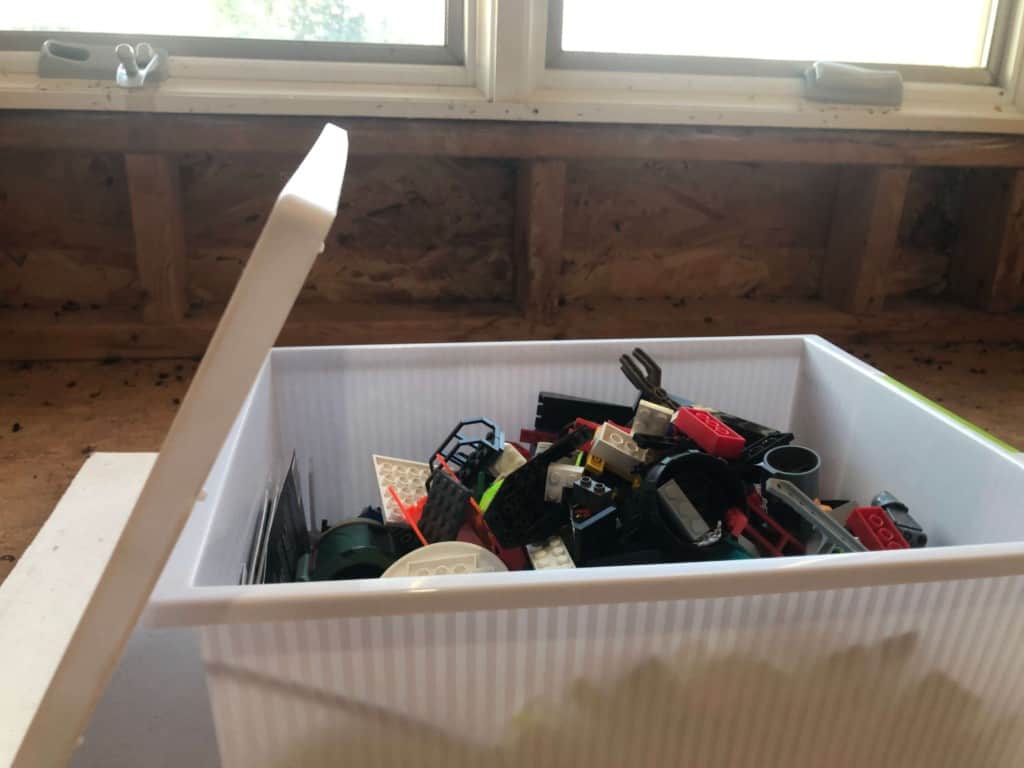LEGOs are awesome. Kids love them. Adults love them. People love LEGOs. But, at some time or another, most people end up storing LEGOs in the attic, leaving them in a hot car, or putting them somewhere else where they can get quite hot. This raises the question: Do LEGOs melt?
Most modern LEGO bricks are made from ABS plastic, which has a melting point of 221⁰F (105⁰C). At 320⁰F (160⁰C), LEGOs will have surpassed the melting point and the plastic will be liquified. So, LEGOs won’t melt under normal conditions, but they can melt in extreme heat.
Many parents wonder what conditions are safe for storing LEGOs, for fear that the bricks may actually melt into an ooey-gooey mess while in storage, rendering them unusable.
On the other hand, some folks like to use LEGOs for crafting. In which case, you may actually WANT to get your LEGOs to melt. In either case, read on to find the key info you’ll want about how LEGOs react at different temperatures.
Table of Contents
Do LEGOs Melt? What Temperature?

Modern LEGOs are made of primarily two materials:
- ABS (Acrylonitrile Butadiene Styrene)
- Polycarbonate Plastic
The majority of LEGOs are made of ABS, which is easy to color during manufacturing, allowing LEGO to make those colorful bricks we’re accustomed to seeing. These have a basic melting point of 221⁰F (105⁰C).
You can watch the melting process in the below step-by-step video, which is incredibly interesting. Or, if you’re short on time, I think you’ll find it helpful to skim through the table I’ve put together below the video:
Summary Table: How Legos React to Heat
| ⁰F | ⁰C | State of Legos (Material: ABS Plastic) |
| <131 | <55 | Durable, no change |
| 131 | 55 | Weakening of brick structure; malleability |
| 176 | 80 | Although weak, bricks still hold structure even under pressure |
| 185 | 85 | Visible deformations occur |
| 221 | 105 | ABS melting point (i.e. LEGO melting point) |
| 248 | 120 | Mild smoke release |
| 257 | 125 | Discoloration of color or “tanning” of bricks |
| 284 | 140 | Emit heavy smoke, bricks are severely deformed |
| 320 | 160 | LEGOs begin to take on a sheen as they liquify |
| >752 | >400 | LEGOs pose a health risk, potentially releases cancer-causing agents |
Translucent bricks actually have a higher heat tolerance than might be expected. Made from the more heat-resistant material, polycarbonate plastic, these bricks have a melting point of 550-600⁰F (288-316⁰C).
LEGO Materials and Melting Points Have Changed over Time
Previous to the 1970s, another material, cellulose acetate (CA), was the primary component of LEGO bricks.
CA had more than double the melting point of ABS at 463⁰F (239⁰C). During a short period of time, they made LEGOs with both ABS and CA together before making the switch entirely to ABS.
For your convenience, here is a table for you to quickly cross-reference materials and melting points:
| Material | Melting Point |
| ABS | 221⁰F (105⁰C) |
| Polycarbonate Plastic | 550⁰F (288⁰C) |
| CA | 463⁰F (239⁰C) |
This is helpful to keep in mind if you have some really old “heirloom” LEGOs from prior to the 70’s. You need to worry even less about these older LEGOs melting in storage.
Will LEGOs Melt in the Attic?
If your attic is like ours, it gets REALLY hot up there. So, it’s very reasonable to wonder whether your LEGO bricks will be able to withstand the heat.
Imagining a Rubbermaid tub full of melted and mangled LEGOs is not a pretty picture. Here’s the quick facts.
An unventilated attic can reach temperatures of 150⁰F (65.5⁰C) in the summertime depending on how hot it gets where you live.
This is below the melting point of LEGOs, which is 221⁰F (105⁰C). However, LEGO bricks are safest at temperatures below 113⁰F (45⁰C), and they become malleable at 131⁰F (55⁰C).
So, it’s unlikely that LEGOs will melt in the attic, but you may still want to avoid storing your LEGOs in places that are prone to extremely high temperatures.
Taking this a step further, if you do think that your attic might get REALLY hot. You can review the information below to consider how hot the attic might get, and whether you should ultimately store your LEGOs there or not:
- Is your attic ventilated or unventilated? An unventilated attic retains significantly more heat than a ventilated attic.
- Is there a heat source in the attic that emits additional heat? For example, a space heater. Or even a piece of equipment that vents heat into the attic.
- Does the attic receive any direct sunlight? If your attic gets a lot of direct sunlight or has big windows going into it, that can also contribute to the peak temperatures.
- Monitor the temperature of the storage space. At the end of the day, if you want to be precise, you can take temperature measurements to evaluate the suitability of your attic (or other space) for storage. Remember that:
- The melting point of ABS is 221⁰F (105⁰C)
- LEGO bricks begin to deform as temperatures approach 185⁰F (85⁰C)
- LEGOs are safest at temperatures <113⁰F (45⁰C)
While LEGOs may be more vulnerable to deformation due to a weakening of the ABS structure during peak summer seasons when stored in an unventilated attic, there is a very low probability of the bricks actually melting.
More on LEGO Storage
If LEGOS get overheated and are left undisturbed, it’s likely they will still retain their original shape upon cooling. For this reason, you may choose to wait to bring your colored bricks out of storage until a cooler season.
It is best to store the LEGOs away from direct sunlight. You may want to find an area for storage that receives little to no direct sun during the day, such as in a corner or behind a larger object.
A simple alternative would be to store LEGOs in an opaque container, like a box or tub. Although sunlight will not cause the bricks to melt, it will accelerate their decomposition and cause the color to fade, leaving them brittle and discolored.
A final consideration is whether there is a heat source (such as a furnace) in the attic. If so, make sure to store the LEGO bricks a safe distance away from it, as the surrounding air temperature will be elevated. In this case, you may run the risk of the bricks melting.
Cool Places to Store LEGO Bricks and Crafts
While there is a very low risk of LEGOs actually melting when stored in the attic, you may still be skeptical. That’s okay. The good news is that they can easily be stored just about anywhere else. Here are some alternatives:
- Basements: They are typically cool and dark. Just make sure to keep them in a dry area.
- Storage Closets: Out of the way, cool, dark, and dry.
Crafts made from LEGOs should be treated the same as individual bricks. Nothing has changed from their basic composition by putting them together, and the same guidelines apply.
Here Are Some Tips for Crafting With LEGOs
LEGO bricks can work great for crafts. Just make sure to pay attention to the type of LEGOs you are gathering/purchasing are appropriate in relation to the project you are planning.
You can still find older bricks on the market that are more heat-resistant and durable
You Don’t Need to Heat the Bricks to Get Creative
There may be some projects that LEGOs simply are not suited to—for example, creating a LEGO oven or candle holder – unless it is solely decoration-only.
Heat and LEGOs don’t mix well unless you are purposely going for a distorted look.
In addition, heating the bricks can create a hazardous, potentially toxic environment. Avoid using heat/flames with LEGOs when crafting. In particular, avoid open flames as well as using the oven (especially at high heat).
If using the oven is necessary, make sure to revisit the properties of ABS and make sure you provide plenty of ventilation. A relatively low heat can cause the LEGOS to begin to deform without any toxic side effects.
If you want the LEGO shapes and colors to remain intact, your best bet is to use a hot glue gun or strong craft glue.
But, if you want to be on the safe side, just don’t heat LEGOs at all.
There are many really amazing projects that you can put together without using any sort of heat. This article has some great examples, such as building a chessboard or even a snow globe! Another relatively new trend is to incorporate LEGOs into a wall or room divider.
In Conclusion
LEGOs are fairly resilient little bricks. They resist wear-and-tear, and to a point, they resist some heat.
Pay attention to the temperature and storage considerations we mentioned above, and take good care of your LEGOs.
LEGOs are awesome. And, with proper care, they can last for decades.
Related Questions
Do Legos float?
Lego bricks and Lego boats will often float, but not always. Legos are made of ABS plastic, which is slightly more dense than water and does not float by itself. However, some Lego bricks (and boats) are able to float when they have the right buoyancy, density, and surface tension.
Are Legos Compatible With Mega Construx (Or Mega Bloks)?
Legos are generally compatible with Mega Construx and Mega Bloks. However, the Mega brand tends to make lower quality (or less consistent) bricks. When using Mega Construx with Legos, you will sometimes find pieces that don’t fit quite right, because of small differences in the size, shape, or quality.
